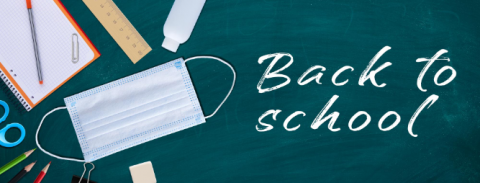
Submitted on Wed, 08/19/2020 - 11:21
Dear Parents:
School is now in session. We would like to review precautions that your family can take to decrease the risk of contracting COVID-19.
Please keep in mind that the following recommendations are based on information available at this time and that they are subject to change.
An easy way to remember the three most important actions you can take is to think of the 3 Ws—Wear a Mask, Watch your Distance, and Wash your Hands.
Wear your mask: Scientific evidence shows conclusively that masks work.
Children ages 2 and older should wear a mask or cloth face covering when they cannot physically distance from others, including at school.
In addition to protecting the child, masks reduce the spread of the virus that causes COVID-19 and other respiratory infections. They stop a substantial portion of the droplets coming out of our mouth and nose when we talk, sneeze, cough, or sing that could infect others. People without symptoms can transmit the virus; therefore, masks work best when everyone wears them.
Wearing the mask or face covering at home helps to protect any family members at risk of severe disease if they contract the virus.
Masks are safe. We wear them all day. Masks do not lower the oxygen a person breaths or retain the CO2 that a person exhales. They do not harm the immune system.
Who shouldn’t wear a mask? Only children under 2 years of age, persons with difficulty breathing, who are unconscious, or who otherwise cannot remove the mask by themselves.
Masks with an exhalation valve or vent do not prevent the spread of COVID-19 and the CDC recommends against using them.
Do cloth masks work? Yes.
Do surgical masks, now widely available, work even better? Yes.
Here are some tips on children wearing a mask:
- Explain to our children at a developmentally appropriate level why they need to wear a mask. See the link to the article below from Healthychildren.org for good ideas.
- Pick designs that are attractive to your children. If possible, involve them in the selection.
- Have your children practice wearing the mask at home for prolonged periods of time.
- Remind them that the outside of the mask is dirty. If they touch it, they need to wash their hands with soap or use hand sanitizer.
It is not known at this time how effective face shields without a mask are. At this time, the CDC does not recommend face shields without a mask.
Watch your distance: Keep 6 feet apart from people not living in your household. Avoid crowds and gatherings. Well-ventilated and outdoor areas are preferred.
Wash your hands: Remind your children to frequently wash their hands with soap and water for 20 seconds (sing Happy Birthday twice) or use hand sanitizer if they cannot wash.
Other important practices:
- Keep your children at home if they have a fever, cough, nasal congestion, runny nose, vomiting, diarrhea, or feel sick.
- Remind your children to avoid touching their faces.
- Upon arrival from school or other outside activities, instruct your children to remove their shoes and leave them outside the house or by an outside door, wash their hands for 20 seconds, remove their clothing, and get in the shower or bath.
- Clothes should be laundered with the highest temperature that the fabric will tolerate.
- Frequently clean and sanitize high touch surfaces, including door knobs, cabinet handles, remote control units, and light switches.
Respectfully,
Interlachen Pediatrics
Helpful Links
Cloth Face Coverings for Children
American Academy of Pediatrics Recommendations for Cloth Face Coverings

